| Article ID | Journal | Published Year | Pages | File Type |
|---|---|---|---|---|
| 5035007 | Journal of Retailing | 2017 | 19 Pages |
â¢Theory identifies two motivations of ED: anti-competitive and efficiency-enhancing.â¢In the French retail chains, both motivations are found, manifesting in different contexts.â¢Efficiency-enhancing ED arises in less concentrated sectors.â¢Anti-competitive ED is present in highly standardized product markets.â¢ED promotes various investment practices, leading to contrasting impacts on retailers.
As one of the most common business practices in retailing, exclusive dealing (ED) restrictions are of great importance for business participants, academics and policy makers. Despite the rich theoretical analysis of this type of vertical restraint, evidence on the rationales of ED remains scarce. This paper uses a simple model to survey the vast theoretical literature on ED, and identifies two opposing motivations for ED contracts: anti-competitive versus efficiency-enhancing motivations. The theoretical predictions are subject to empirical investigation using unique French cross-sectional data encompassing diverse retail sectors. Our estimations provide evidence for both types of motivations for ED contracts, manifesting in different contexts. In particular, we find that the efficiency-enhancing motivation is more likely to explain the choice of ED when suppliers are less concentrated, whereas the anti-competitive motivation is present in highly standardized product markets. Moreover, our results reveal a positive linkage of ED and different types of investments, as part of branding strategy, with important retailing and marketing-related implications. In particular, we show that retailers have to be meticulous regarding the conditions of the retail contract before accepting the ED restriction, which may dampen their business efficiency in the long run.
Graphical abstractDownload high-res image (123KB)Download full-size image
